
A striptease is an erotic or exotic dance in which the performer gradually undresses, either partly or completely, in a seductive and sexually suggestive manner. The person who performs a striptease is commonly known as a "stripper" or an "exotic" or "burlesque" dancer.
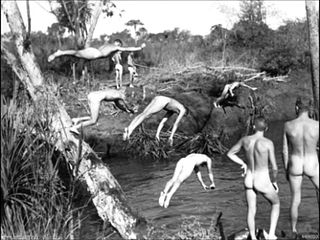
Nude swimming is the practice of swimming without clothing, whether in natural bodies of water or in swimming pools. A colloquial term for nude swimming is "skinny dipping".

Toplessness refers to the state in which a woman's breasts, including her areolas and nipples, are exposed, especially in a public place or in a visual medium. The male equivalent is known as barechestedness.

Nude on the Moon is a 1961 science-fantasy nudist film co-written and co-directed by Doris Wishman and Raymond Phelan under the shared pseudonyms "O. O. Miller" and "Anthony Brooks".

Cerina Vincent is an American actress. She had her breakthrough role starring as Maya in the television series Power Rangers Lost Galaxy, followed by a part in the comedy film Not Another Teen Movie, before going on to star in the horror film Cabin Fever, which established her as a "scream queen" and led to further roles in horror movies. More recently, she appeared as Suzy Diaz in the Disney Channel series Stuck in the Middle. She has also written three books with Jodi Lipper, wrote a regular column for The Huffington Post, and co-hosts the podcast Raising Amazing with Dr. Joel Gator.

Sheree North was an American actress, dancer, and singer, known for being one of 20th Century-Fox's intended successors to Marilyn Monroe.
In film, nudity may be either graphic or suggestive, such as when a person appears to be naked but is covered by a sheet. Since the birth of film, depictions of any form of sexuality have been controversial, and in the case of most nude scenes, had to be justified as part of the story.

Red Dust is a 1932 American pre-Code romantic drama film directed by Victor Fleming, and starring Clark Gable, Jean Harlow, and Mary Astor. It is based on the 1928 play of the same name by Wilson Collison, and was adapted for the screen by John Mahin. Red Dust is the second of six movies Gable and Harlow made together. More than 20 years later, Gable starred in a remake, Mogambo (1953), with Ava Gardner starring in a variation on the role Harlow played and Grace Kelly playing a part similar to one portrayed by Astor in Red Dust.
Nudity in American television is a controversial topic. Aside from a few exceptions, nudity in the United States has traditionally not been shown on terrestrial television. On the other hand, cable television has been much less constrained as far as nudity is concerned.

Shirley Olivia Mills was an American actress. She played the roles of the youngest daughter in The Grapes of Wrath and the title character in Child Bride. In the latter, she is shown nude in a nude swimming scene, filmed when she was about 12 years old, which became the basis for Child Bride being classified for many years as an exploitation film.
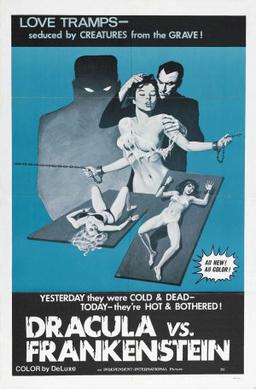
Dracula vs. Frankenstein, released in the UK as Blood of Frankenstein, is a 1971 American science fiction horror film directed and co-produced by Al Adamson. The film stars J. Carrol Naish as Dr. Durea, a descendant of Dr. Frankenstein who is working on a blood serum for his assistant Groton. The serum soon becomes sought after by Count Dracula, who hopes that it will grant him the ability to be exposed to sunlight without harm. Other members of the film's cast include Anthony Eisley, Regina Carrol, and Angelo Rossitto.

Me, Natalie is a 1969 American comedy-drama film directed by Fred Coe about a homely young woman from Brooklyn who moves to Greenwich Village and finds romance with an aspiring painter. The screenplay by A. Martin Zweiback is based on an original story by Stanley Shapiro. Patty Duke, who starred in the title role, won a Golden Globe Award for her performance. The film also starred James Farentino, Salome Jens, Elsa Lanchester, Martin Balsam and Nancy Marchand. It marked Al Pacino's film debut.
Mr. Skin is a website that specializes in locating, posting, and rating instances of female nudity in television and film. Founded in August 1999, Mr. Skin is also the nickname of the company's chief executive, Jim McBride. MrSkin.com attracted more than seven million visitors per month in 2007, going up to over ten million in 2014. As of 2017, the site has more than nine million visitors per month.

Angelo Salvatore Rossitto was an American actor and voice artist. He had dwarfism and was 2'11" (89 cm) tall, and was often billed as Little Angie or Moe. Angelo first appeared in silent films opposite Lon Chaney and John Barrymore. On screen, he portrayed everything from dwarfs, midgets, gnomes and pygmies as well as monsters, villains and aliens, with appearances in more than 70 films.
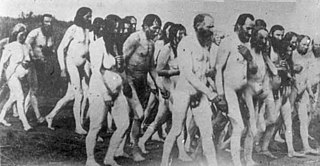
Nudity is sometimes used as a tactic during a protest to attract media and public attention to a cause, and sometimes promotion of public nudity is itself the objective of a nude protest. The practice was first documented in the 1650s with Quakers "naked as a sign" practice. Later the tactic was used by svobodniki in Canada in 1903, and photographs of their nude protests have been published. The tactic has been used by other groups later in the century, especially after the 1960s. Like public nudity in general, the cultural and legal acceptance of nudity as a tactic in protest also varies around the world. Some opponents of any public nudity claim that it is indecent, especially when it can be viewed by children; while others argue that it is a legitimate form of expression covered by the right to free speech.
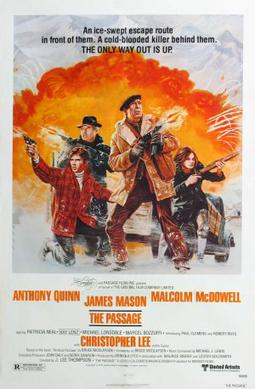
The Passage is a 1979 British action-war film directed by J. Lee Thompson and starring Anthony Quinn, James Mason, Malcolm McDowell and Patricia Neal. The film is based upon the 1976 novel Perilous Passage by Bruce Nicolaysen, who also wrote the screenplay for the film.
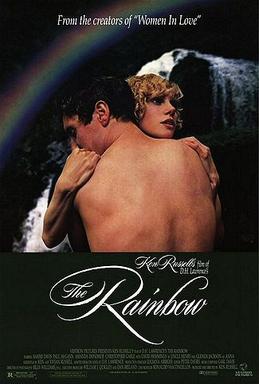
The Rainbow is a 1989 British drama film co-written and directed by Ken Russell and adapted from the D. H. Lawrence novel The Rainbow (1915). Sammi Davis stars as Ursula, a sheltered young pupil, then schoolteacher, who is taken under the wing by the more sophisticated Winifred.

Crissy Moran is a Christian public speaker who is a former American pornographic actress. She began working in adult entertainment in 1999, and between 2001 and 2006 had performed in over 50 adult films. In 2006, Moran became a devout Christian and quit working in the adult industry. After retirement, she began speaking about her experiences in porn and appearing in national media projects addressing what she considers "the harms of pornography," associating adult films with human sex trafficking and the exploitation of women and children.

Anneka Di Lorenzo, later Anneka Vasta, was an American exploitation film star and nude model.

The marriage of 22-year-old Charlie Johns and nine-year-old Eunice Winstead was an occurrence of child marriage that happened in the state of Tennessee, United States, in 1937. The event received national attention after Life magazine published an article about the union in February of the same year.
Note: The 1943 date cited refers to the copyright/release/re-release date. It was filmed in 1938/1939 because Shirley Mills was born in 1926, and it is widely known that she was 12 at that time, and not 17.

















